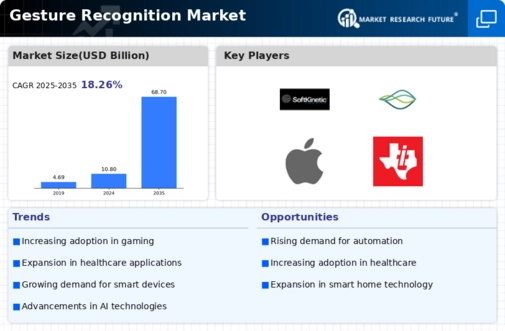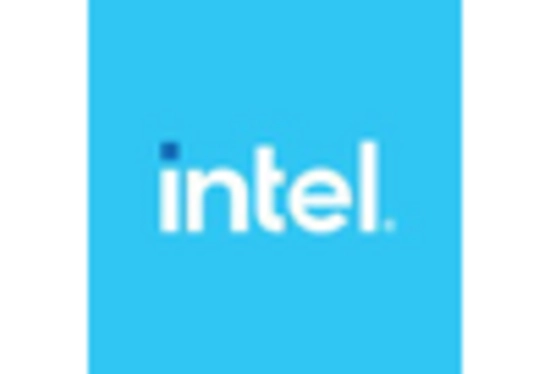-
Market Dynamics
-
Market Drivers
- Processor Manufacturers
- Emergence of Gestures as a New Way
- Development of Motion-Control Gaming
- Growing Consumer Electronics Market
-
Incorporating Gesture Recognition
-
of Communicating with Machines
-
Market Inhibitors
- Technical Challenges in 3D Gestural
-
1.2.1
-
Limiting Capabilities of Hardware
-
Interaction
-
Supply Chain Analysis
-
Porter’s Five Forces Analysis
-
Global Gesture Recognition Market, by Technology
-
Introduction
-
2.2
-
Sensor
-
2D Gesture Technology
-
3D Gesture Technology
-
Global
-
Gesture Recognition Market, by Application
-
Introduction
-
Automotive
-
Healthcare
-
Consumer Electronics
-
Transportation
-
3.6
-
Commercial
-
IT/Telecom
-
Others
-
Global Gesture Recognition
-
Market, by Product
-
Introduction
-
Touchless
-
Touch-based
-
Regional Market Analysis
-
Introduction
-
North America
-
5.3
-
Europe
-
Asia-Pacific
-
Rest of the World
-
Company Profiles
-
Key Players Ranking
-
Microsoft Corporation
- Business Overview
- Product/Services Offered
- Key Strategies
- SWOT Analysis
-
Intel Corporation
- Business Overview
- Product/Services
- Key Strategies
- SWOT Analysis
-
Offered
-
Apple Inc.
- Business Overview
- Product/Services Offered
- Key Strategies
- SWOT Analysis
-
Iris guard
- Business Overview
- Key Strategies
-
6.5.2
-
Product/Services Offered
-
Qualcomm Incorporated
- Business Overview
- Product/Services Offered
- Key Strategies
- SWOT Analysis
-
Omron Corporation
- Business Overview
- Product/Services Offered
- Key Strategies
- SWOT Analysis
-
SoftKinetic Inc.
- Business Overview
- Product/Services
- Key Strategies
-
Offered
-
Texas Instruments
- Business
- Product/Services Offered
- Key Strategies
-
Overview
-
6.9.4
-
SWOT Analysis
-
Infineon Technologies AG
- Business Overview
- Product/Services Offered
- Key Strategies
- SWOT Analysis
-
Appendix
-
Scope of the Study
- Research Objective
- Limitation
-
7.1.2
-
Assumption
-
Market Structure
-
Research Methodologies
-
Research Process
-
Primary Research
-
Secondary Research
-
Market Size Estimation
-
Forecast Model
-
List of Tables
-
TABLE
-
MARKET FACTOR ANALYSIS
-
GLOBAL GESTURE RECOGNITION MARKET, BY TECHNOLOGY
-
(USD BILLION)
-
SENSOR TECHNOLOGY, GESTURE RECOGNITION MARKET, BY REGION
-
(USD BILLION)
-
2D GESTURE TECHNOLOGY GESTURE RECOGNITION MARKET, BY
-
REGION (USD BILLION)
-
3D GESTURE TECHNOLOGY GESTURE RECOGNITION MARKET,
-
BY REGION (USD BILLION)
-
GLOBAL GESTURE RECOGNITION MARKET, BY APPLICATION
-
(USD BILLION)
-
AUTOMOTIVE GESTURE RECOGNITION MARKET, BY REGION (USD
-
BILLION)
-
HEALTHCARE GESTURE RECONGNITION MARKET, BY REGION (USD BILLION)
-
CONSUMER ELECTRONIC, GESTURE RECOGNITION MARKET, BY REGION (USD BILLION)
-
TRANSPORT GESTURE RECOGNITION MARKET, BY REGION (USD BILLION)
-
TABLE
-
COMMERCIAL GESTURE RECOGNITION MARKET, BY REGION (USD BILLION)
-
TABLE 12
-
IT/TELECOM GESTURE RECOGNITION MARKET, BY REGION (USD BILLION)
-
OTHERS
-
GESTURE RECOGNITION MARKET, BY REGION (USD BILLION)
-
GLOBAL GESTURE
-
RECOGNITION MARKET, BY PRODUCT (USD BILLION)
-
TOUCHLESS GESTURE RECOGNITION
-
MARKET, BY APPLICATION (USD BILLION)
-
TOUCHBASED GESTURE RECOGNITION
-
MARKET, BY APPLICATION (USD BILLION)
-
GLOBAL GESTURE RECOGNITION MARKET,
-
BY REGION (USD BILLION)
-
NORTH AMERICA GESTURE RECOGNITION MARKET,
-
BY COUNTRY (USD BILLION)
-
NORTH AMERICA GESTURE RECOGNITION MARKET,
-
BY TECHNOLOGY (USD MILLION)
-
NORTH AMERICA GESTURE RECOGNITION MARKET,
-
BY APPLICATION (USD BILLION)
-
EUROPE GESTURE RECOGNITION MARKET, BY
-
COUNTRY (USD BILLION)
-
EUROPE GESTURE RECOGNITION MARKET, BY TECHNOLOGY
-
(USD BILLION)
-
EUROPE GESTURE RECOGNITION MARKET, BY APPLICATION (USD
-
BILLION)
-
ASIA PACIFIC GESTURE RECOGNITION MARKET, BY COUNTRY (USD
-
BILLION)
-
ASIA PACIFIC GESTURE RECOGNITION MARKET, BY TECHNOLOGY (USD
-
BILLION)
-
ASIA PACIFIC GESTURE RECOGNITION MARKET, BY VERTICAL (USD
-
BILLION)
-
REST OF THE WORLD GESTURE RECOGNITION MARKET, BY TECHNOLOGY
-
(USD BILLION)
-
REST OF THE WORLD GESTURE RECOGNITION MARKET, BY APPLICATION
-
(USD BILLION)
-
List of Figures
-
GLOBAL GESTURE RECOGNITION MARKET:
-
DRIVERS & RESTRAINT
-
GLOBAL GESTURE RECOGNITION MARKET: SUPPLY
-
CHAIN PROCESS
-
GLOBAL GESTURE RECOGNITION MARKET: PORTER’S FIVE
-
FORCES ANALYSIS
-
GLOBAL GESTURE RECOGNITION MARKET, BY TECHNOLOGY (USD
-
BILLION)
-
SENSOR TECHNOLOGY, GESTURE RECOGNITION MARKET, BY REGION
-
(USD BILLION)
-
2D GESTURE TECHNOLOGY GESTURE RECOGNITION MARKET, BY
-
REGION (USD BILLION)
-
3D GESTURE TECHNOLOGY GESTURE RECOGNITION MARKET,
-
BY REGION (USD BILLION)
-
GLOBAL GESTURE RECOGNITION MARKET, BY APPLICATION
-
(USD BILLION)
-
AUTOMOTIVE GESTURE RECOGNITION MARKET, BY REGION (USD
-
BILLION)
-
HEALTHCARE GESTURE RECONGNITION MARKET, BY REGION (USD BILLION)
-
CONSUMER ELECTRONIC, GESTURE RECOGNITION MARKET, BY REGION (USD BILLION)
-
TRANSPORT GESTURE RECOGNITION MARKET, BY REGION (USD BILLION)
-
FIGURE
-
COMMERCIAL GESTURE RECOGNITION MARKET, BY REGION (USD BILLION)
-
FIGURE 14
-
IT/TELECOM GESTURE RECOGNITION MARKET, BY REGION (USD BILLION)
-
OTHERS
-
GESTURE RECOGNITION MARKET, BY REGION (USD BILLION)
-
GLOBAL IOT MANAGED
-
SERVICES MARKET, BY ORGANIZATION SIZE (USD MILLION)
-
TOUCHLESS GESTURE
-
RECOGNITION MARKET, BY APPLICATION (USD BILLION)
-
TOUCHLESS GESTURE
-
RECOGNITION MARKET, BY APPLICATION (USD BILLION)
-
GLOBAL GESTURE RECOGNITION
-
MARKET, BY REGION (USD BILLION)
-
NORTH AMERICA GESTURE RECOGNITION
-
MARKET, BY COUNTRY (USD BILLION)
-
NORTH AMERICA GESTURE RECOGNITION
-
MARKET, BY TECHNOLOGY (USD BILLION)
-
NORTH AMERICA GESTURE RECOGNITION
-
MARKET, BY APPLICATION (USD BILLION)
-
EUROPE GESTURE RECOGNITION MARKET,
-
BY COUNTRY (USD BILLION)
-
EUROPE GESTURE RECOGNITION MARKET, BY TECHNOLOGY
-
(USD BILLION)
-
EUROPE GESTURE RECOGNITION MARKET, BY APPLICATION (USD
-
BILLION)
-
ASIA-PACIFIC GESTURE RECOGNITION MARKET, BY COUNTRY (USD
-
BILLION)
-
ASIA-PACIFIC GESTURE RECOGNITION MARKET, BY TECHNOLOGY (USD
-
BILLION)
-
ASIA-PACIFIC GESTURE RECOGNITION MARKET, BY VERTICAL (USD
-
BILLION)
-
REST OF THE WORLD GESTURE RECOGNITION MARKET, BY TECHNOLOGY
-
(USD BILLION)
-
REST OF THE WORLD GESTURE RECOGNITION MARKET, BY APPLICATION
-
(USD BILLION)
-
GLOBAL GESTURE RECOGNITION MARKET STRUCTURE
-
FIGURE
-
MRFR RESEARH PROCESS









Leave a Comment